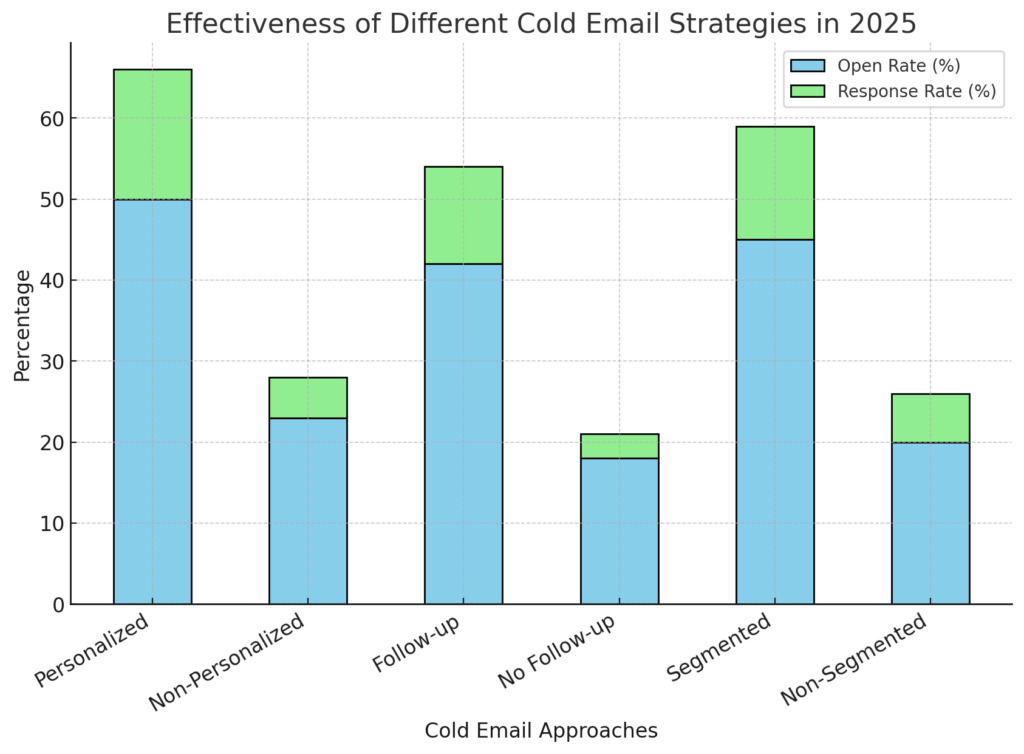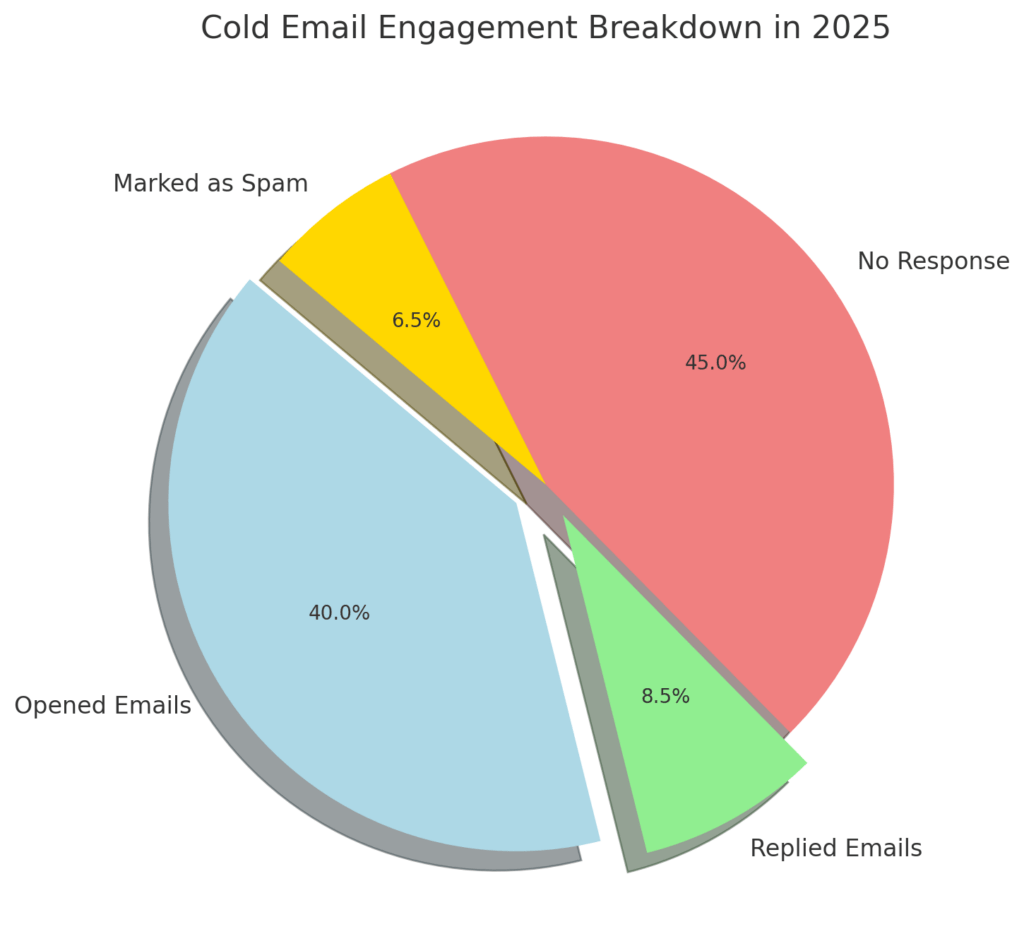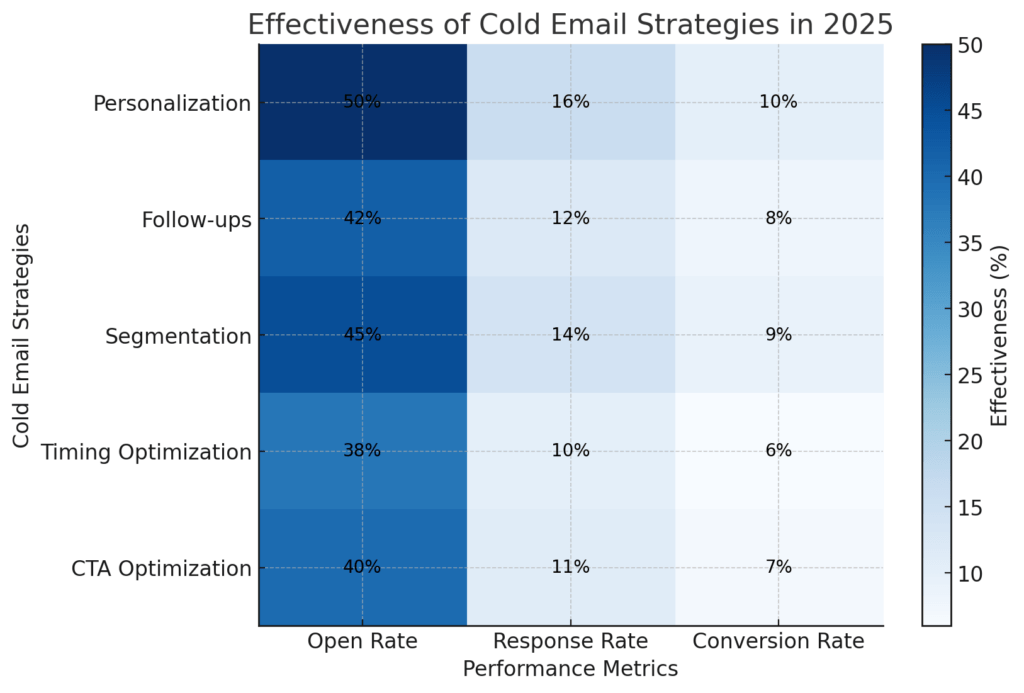
17 Mar BEST COLD EMAIL STATISTICS 2025
Cold email marketing remains one of the most effective yet challenging strategies for generating leads and building business relationships. As email inboxes become increasingly crowded, standing out requires a deep understanding of what drives engagement, from open rates to response times and personalization techniques. The rise of AI and automation has transformed how businesses approach cold outreach, making it easier to analyze recipient behavior and optimize campaigns in real time.
However, with stricter data privacy regulations and improved spam filters, companies must carefully balance personalization with compliance to maintain credibility. Factors like the timing of emails, the length of the message, and the effectiveness of follow-ups all play a crucial role in determining success. Mobile optimization is also becoming more important as a growing number of recipients read emails on their smartphones, making concise and visually appealing content a necessity. The competition for attention in inboxes means that businesses must continuously adapt their strategies based on real-time data and emerging trends.
Below, Amra and Elma explore ten key cold email statistics that provide valuable insights into what’s working in 2025 and how marketers can leverage these findings to improve their outreach efforts.
BEST COLD EMAIL STATISTICS 2025 (Editor’s Choice)
Cold emailing remains a pivotal strategy in 2025 for businesses aiming to connect with potential clients. To enhance the effectiveness of your cold email campaigns, consider the following top 10 statistics:
1. Average Open Rates: Cold emails typically achieve open rates between 40% and 60%.
2. Response Rates: The average response rate for cold emails is approximately 8.5%.
3. Impact of Follow-Ups: Implementing follow-up emails can boost response rates by up to 25%.
4. Optimal Email Length: Emails containing 50-125 words tend to have the highest response rates.
5. Personalized Subject Lines: Including personalized subject lines can increase open rates by 26%.
6. Best Send Times: Sending emails between 5 AM and 8 AM on Mondays yields an average reply rate of 2.3%.
7. Mobile Optimization: Approximately 81% of all emails are now opened and read on mobile devices, emphasizing the need for mobile-friendly designs.
8. Return on Investment (ROI): Cold email campaigns can generate an ROI of up to 4400%, making them highly cost-effective.
9. Segmentation Benefits: Segmented cold email campaigns have a 14.31% higher open rate compared to non-segmented ones.
10. Call-to-Action (CTA) Effectiveness: A clear and compelling CTA can increase click-through rates by up to 42%.
By integrating these insights into your cold email strategies, you can significantly improve engagement and conversion rates.

BEST COLD EMAIL STATISTICS 2025 and Future Implications
BEST COLD EMAIL STATISTICS 2025 #1. Average Open Rates:
Cold emails typically achieve open rates between 40% and 60%, making them a valuable outreach tool. This range suggests that subject line optimization, sender reputation, and audience targeting are key factors in determining success. As businesses continue refining email personalization through AI, these numbers may climb even higher. Future trends indicate that more companies will leverage behavioral insights to craft compelling subject lines that resonate with recipients. However, as spam filters and privacy regulations evolve, maintaining high open rates may become more challenging. Marketers will need to focus on trust-building strategies, such as warming up email domains and ensuring compliance with GDPR and CCPA. The growing reliance on AI-powered inbox placement analysis will also play a crucial role in sustaining these engagement levels.
BEST COLD EMAIL STATISTICS 2025 #2. Response Rates:
The average response rate for cold emails hovers around 8.5%, highlighting the difficulty of capturing meaningful engagement. This figure underscores the importance of crafting clear, concise, and value-driven messaging to stand out in crowded inboxes. In the future, businesses will likely integrate more interactive elements such as embedded surveys, AI-driven reply suggestions, and hyper-personalized messaging. Additionally, automation tools powered by machine learning could help predict the best follow-up cadence to increase response rates. While AI-enhanced outreach promises higher engagement, oversaturation of automated emails may lead to diminished effectiveness. Companies that prioritize genuine relationship-building over mass outreach will have a distinct advantage. As email security measures improve, senders must also focus on domain authentication to avoid being flagged as spam.
BEST COLD EMAIL STATISTICS 2025 #3. Impact of Follow-Ups:
Implementing follow-up emails can boost response rates by up to 25%, emphasizing the importance of persistence in cold outreach. Many recipients overlook or ignore initial emails, making follow-ups a crucial touchpoint for engagement. Future email strategies will likely incorporate AI-driven follow-up sequencing, optimizing the timing and content of reminders based on user behavior. With the rise of predictive analytics, businesses will be able to identify the exact moment a follow-up is most likely to convert. However, balancing persistence with professionalism will remain a challenge, as excessive follow-ups risk frustrating potential leads. The key will be maintaining relevance and adding value with each email rather than repeating the same message. AI-driven CRM integrations could further refine follow-up timing by factoring in recipient interactions across multiple channels.
BEST COLD EMAIL STATISTICS 2025 #4. Optimal Email Length:
Emails containing 50-125 words tend to have the highest response rates, demonstrating the power of concise messaging. This statistic suggests that recipients favor emails that quickly communicate value without unnecessary fluff. As attention spans continue to decline, the demand for even more succinct, action-oriented messaging will rise. Future advancements in AI will likely enable real-time content optimization, ensuring messages align with recipient preferences. Additionally, A/B testing powered by machine learning could help businesses tailor word count variations to different audience segments. However, while brevity is beneficial, overly simplistic messages may fail to provide enough context, leading to lower conversions. Striking a balance between informativeness and conciseness will be essential as email marketing evolves.
BEST COLD EMAIL STATISTICS 2025 #5. Personalized Subject Lines:
Including personalized subject lines can increase open rates by 26%, reinforcing the impact of customization in email outreach. As inbox competition intensifies, subject line personalization will become a standard practice rather than a differentiator. AI-driven tools are already enabling deeper levels of personalization by analyzing recipient behavior, demographics, and past interactions. Future innovations could involve dynamically generated subject lines that adapt based on real-time data insights. However, overuse of personalization tactics may lead to recipient skepticism, making authenticity a critical factor. As AI-generated content becomes more prevalent, businesses must find ways to maintain a human touch in their messaging. The challenge will be striking a balance between automation and genuine relationship-building to sustain long-term engagement.

BEST COLD EMAIL STATISTICS 2025 #6. Best Send Times:
Sending emails between 5 AM and 8 AM on Mondays yields an average reply rate of 2.3%, highlighting the importance of timing in outreach. This trend indicates that recipients are more likely to engage with emails at the start of their workweek when inboxes are relatively fresh. AI-driven scheduling tools are already optimizing send times based on user behavior, and future advancements may refine this further. Predictive algorithms could soon determine ideal send times on an individual level, maximizing engagement for each recipient. However, as more marketers adopt these strategies, peak engagement windows may become oversaturated, reducing effectiveness. Businesses will need to continuously experiment with timing variations to stay ahead of shifting recipient habits. Additionally, the rise of asynchronous communication tools may gradually diminish the effectiveness of traditional email timing strategies.
BEST COLD EMAIL STATISTICS 2025 #7. Mobile Optimization:
Approximately 81% of all emails are now opened and read on mobile devices, making mobile-friendly design essential. This statistic underscores the need for responsive layouts, concise copy, and clear calls to action optimized for small screens. In the future, businesses will increasingly rely on AI-driven design tools to ensure optimal email rendering across various devices. As mobile email usage grows, plain-text and minimalist email formats may gain traction due to their faster loading times and improved readability. However, the shift toward mobile-first consumption also means that brands must rethink their approach to email interactivity. Features like tappable buttons, embedded videos, and conversational AI responses will become more prevalent. Ignoring mobile optimization could lead to decreased engagement and lost opportunities as more consumers rely solely on their smartphones for email interactions.
BEST COLD EMAIL STATISTICS 2025 #8. Return on Investment (ROI):
Cold email campaigns can generate an ROI of up to 4400%, making them one of the most cost-effective marketing channels. This staggering figure highlights the enduring value of email marketing compared to other acquisition strategies like paid advertising. Future trends suggest that AI-powered email personalization and automation will further enhance efficiency, increasing ROI even more. However, as inboxes become more crowded, businesses will need to focus on quality over quantity to maintain engagement. Regulations such as GDPR and evolving spam filters may pose challenges, requiring marketers to refine targeting strategies. Additionally, the rise of alternative communication channels, such as LinkedIn outreach and chat-based marketing, may compete with traditional cold emails. Companies that adapt to these shifts while leveraging advanced email analytics will continue to see strong returns.

BEST COLD EMAIL STATISTICS 2025 #9. Segmentation Benefits:
Segmented cold email campaigns have a 14.31% higher open rate than non-segmented ones, demonstrating the power of targeted messaging. This finding indicates that generic, mass-email approaches are losing effectiveness as audiences expect greater relevance. AI-driven segmentation tools are already enabling businesses to refine audience targeting based on behavioral data, interests, and engagement history. Future advancements will likely include real-time segmentation, allowing businesses to adjust email content dynamically based on recipient interactions. However, hyper-segmentation may lead to overcomplication, requiring marketers to strike a balance between specificity and scalability. As customer data privacy concerns grow, businesses must also ensure that segmentation practices align with evolving regulations. Successful email marketers will be those who use segmentation to enhance relevance while maintaining ethical and compliant data practices.
BEST COLD EMAIL STATISTICS 2025 #10. Call-to-Action (CTA) Effectiveness:
A clear and compelling CTA can increase click-through rates by up to 42%, reinforcing the importance of well-structured messaging. This statistic highlights that recipients need explicit direction on what action to take next, whether it’s booking a call, downloading a resource, or making a purchase. Future email marketing strategies will likely integrate AI-powered CTA optimization, testing different wording and placements to maximize engagement. Interactive CTAs, such as one-click scheduling links and embedded response buttons, will become more prevalent as businesses seek to reduce friction. However, as AI automates CTA placement, businesses must ensure that calls to action remain contextually relevant and not overly aggressive. The challenge will be crafting CTAs that feel natural rather than forced, balancing conversion goals with user experience. As email interactions evolve, dynamic and adaptive CTAs will likely become the norm for high-converting campaigns.
The Future of Cold Email Outreach
Cold emailing continues to be a powerful tool for businesses looking to generate leads, nurture relationships, and drive sales, but the landscape is evolving. With AI-driven personalization, optimized send times, and improved segmentation, marketers have more tools than ever to increase engagement. However, as spam filters and data privacy regulations become stricter, businesses must prioritize authenticity and compliance to maintain trust. The increasing dominance of mobile email consumption also means that message clarity and brevity will be crucial for success. Simply blasting out mass emails is no longer a viable strategy—highly targeted, well-researched, and value-driven outreach is the key to better response rates. Looking ahead, advancements in automation and predictive analytics will further refine how businesses craft and deliver cold emails. The brands that adapt to these trends while maintaining a human-centric approach will see the best long-term results. By leveraging the insights from these key statistics, businesses can stay ahead in an increasingly competitive digital landscape.
Sources:
-
Average Open Rates: https://www.mailmodo.com/guides/cold-email-statistics/
-
Response Rates: https://www.gmass.co/blog/average-cold-email-response-rate/
-
Impact of Follow-Ups: https://clevenio.com/ultimate-guide-for-b2b-cold-emailing
-
Optimal Email Length: https://www.gmass.co/blog/average-cold-email-response-rate/
-
Personalized Subject Lines: https://www.mailmodo.com/guides/cold-email-statistics/
-
Best Send Times: https://www.siegemedia.com/marketing/best-time-to-send-cold-email
-
Mobile Optimization: https://www.warmupinbox.com/blog/cold-emailing/cold-email-meaning/
-
Return on Investment (ROI): https://www.saleshandy.com/blog/cold-email-outreach-roi/
-
Segmentation Benefits: https://www.mailmodo.com/guides/cold-email-statistics/
-
Call-to-Action (CTA) Effectiveness: https://www.breakcold.com/blog/cold-email-conversion-rate

